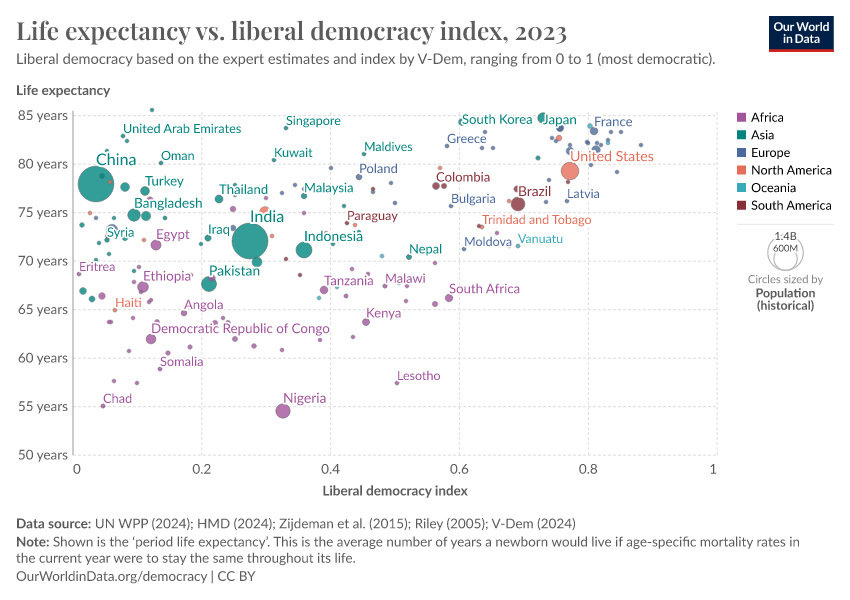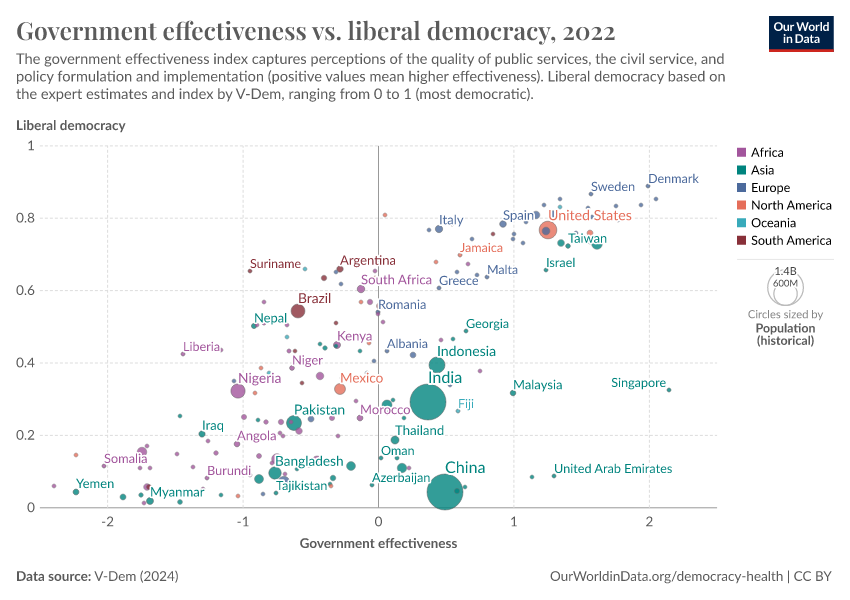Does democracy lead to better health?
There is a cross-country correlation between democracy and health. Is there good evidence to suggest it is causal?
In his book Development as Freedom Amartya Sen says that in functioning multiparty democracies "rulers have the incentive to listen to what people want if they have to face their criticism and seek their support in elections”.1
Sen made this point in the context of food crises, famously pointing out that famines tend not to happen in democracies. But his argument is general, and the idea that strong democratic institutions can improve social outcomes is very popular in international development circles.
What do we know about the empirical support that links democracy and population health?
The cross-country correlation between democracy and health
The chart shows the cross-country correlation between an aggregate measure of health – life expectancy – and an aggregate measure of democracy, the Liberal Democracy Index.
The Liberal Democracy Index is produced by the Varieties of Democracy project at the University of Gothenburg. The index is based on a qualitative and quantitative assessment of elections and suffrage rights; freedom of expression and association; equality before the law; and judicial and legislative constraints on the executive. It is measured in a continuous scale where more democratic regimes obtain higher scores.2
As we can see, there is a general correlation: all countries with a high score on the Liberal Democracy Index have long life expectancies, and all countries with relatively short life expectancies have low scores.
This correlation holds for other measures of health and democracy; and several studies have found that it also holds after controlling for other factors such as national income or human capital. In a recent paper published in The Lancet, a group of researchers looked at data covering 170 countries over the period 1970 to 2015, and they concluded that democracies were better than autocracies at reducing mortality — especially in those causes of mortality that had not been heavily targeted by foreign aid and required health-care delivery infrastructure.3
But of course, correlation is not causation. Does democratization actually cause improved health outcomes?
The causal impact of democratization on health outcomes
Controlled experiments are a popular way to establish causality. If we could randomly pick some countries and make them more democratic, we could then take two groups, use one as a control, and wait 30 years to evaluate the impact of democracy on health. While such an experiment is obviously out of the question, sometimes there are 'natural experiments' that enable us to learn about causal relationships following a similar logic.
One such natural experiment was the introduction of electronic voting in Brazil’s complex elections. Under paper balloting, less educated and poorer voters often made mistakes and so had their votes invalidated. In 1998, electronic voting was introduced, but only to municipalities with at least 40,500 registered voters. By comparing municipalities that were just below and above this arbitrary cutoff, Thomas Fujiwara found that electronic voting dramatically reduced the percentage of invalid votes, and this effectively enfranchised millions of voters, most of whom were less educated and poor. This enhanced political participation of the poor led, in turn, to increased spending on public healthcare, with such positive outcomes as fewer low-weight births and increased prenatal visits by healthcare professionals to pregnant women.4
Other studies have also found consistent evidence in other contexts. Masayuki Kudamatsu studied the 1990s wave of democratization in sub-Saharan Africa, and looked at individual-level data for 27,000 mothers who gave birth both before and after the year of democratization. He found that when multiparty elections produced a new leader infant mortality fell. However, there was no such reduction in infant mortality in countries where the dictator held multiparty elections and stayed in power, or where leadership change took place in a nondemocratic way.5
Democracy and public service delivery
The above-mentioned research from Thomas Fujiwara suggests that public service delivery was the key channel through which democracy affected health outcomes in Brazil. So what do we know about the link between democracy and public service delivery more generally?
Several studies have found a link between democratic elections and spending on public goods.6
But the impact of democracy on public service delivery seems to go beyond higher spending. Robin Burgess and coauthors, for example, found that electoral competition can help reduce favoritisms in spending, which can improve social outcomes by reducing biases in public service delivery.7 This is important because democracy often goes together with improved governance, including more control of corruption and better administrative effectiveness and state capacity.8
The correlation between democracy and government effectiveness is shown in the scatter plot, using data from the Government Effectiveness Index, produced by the World Bank as part of the Worldwide Governance Indicators project. Here, government effectiveness captures "perceptions of the quality of public services, the quality of the civil service and the degree of its independence from political pressures, the quality of policy formulation and implementation, and the credibility of the government's commitment to such policies".9
Considering the evidence as a whole, the conclusion is that (i) there is a strong raw cross-country correlation between population health outcomes and the strength of democratic institutions; (ii) there is evidence that these correlations also hold if you control for other variables, but there are some studies that suggest conditional correlations are less robust; (iii) going beyond correlations, there is good evidence suggesting the observed cross-country correlations are likely causal, hence suggesting that democratization leads to better health; and (iv) the causal mechanism is likely driven by a mix of both higher expenditure on public services, and better public service delivery.
Keep reading on Our World in Data
Democracy
How has democracy spread across countries? Are we moving towards a more democratic world? Explore global data and research on democracy.
Endnotes
Sen, A. (1999). Development as freedom (1st. ed). New York: Knopf.
This article of ours describes the Varieties of Democracy data in detail.
There are also some studies that find weak support for conditional cross-country correlations. You can read more about the cross-country evidence in the mentioned Lancet study: Bollyky, T. J., Templin, T., Cohen, M., Schoder, D., Dieleman, J. L., & Wigley, S. (2019). The relationships between democratic experience, adult health, and cause-specific mortality in 170 countries between 1980 and 2016: an observational analysis. The Lancet, 393, 1628–1640. doi: 10.1016/ S0140-6736(19)30235-1.
As Fujiwara explains in his paper, the fact that the enfranchisement of the less educated affect policy is consistent with political economy theories of redistribution: Poorer Brazilians rely mostly on a public-funded system for health care services, while richer voters are more likely to use private services; so the less educated have thus relatively stronger preferences for public health services, and a shift in spending toward health care can be interpreted as redistribution to the poor. The fact that public health spending increased reflects a shift where elected politicians try to get closer to the preferences of the newly enfranchised voters.
The full reference of the paper is: Fujiwara, T. (2015). Voting technology, political responsiveness, and infant health: Evidence from Brazil. Econometrica, 83, 423–464. Available online here.
Kudamatsu, M. (2012). Has democratization reduced infant mortality in sub-Saharan Africa? Evidence from micro data. Journal of the European Economic Association, 10, 1294–1317.
See for example:
- Martinez-Bravo, M., Padró i Miquel, G., & Qian, N. (2012). The effects of democratization on public goods and redistribution: evidence from China. Working Paper available here.
- Stasavage, D. (2005). Democracy and education spending in Africa. American Journal of Political Science, 49(2), 343-358.
Burgess, R., Jedwab, R., Miguel, E., Morjaria, A., & Padró i Miquel, G. (2015). The value of democracy: evidence from road building in Kenya. American Economic Review, 105(6), 1817-51.
Indeed, some studies have found that if you control for quality of government, the partial correlation between elections and health outcomes disappear. At face value this simple correlation suggests elections are not sufficient to guarantee better social outcomes. You can read more about this in Halleröd, B., Rothstein, B., Daoud, A., & Nandy, S. (2013). Bad Governance and Poor Children: A Comparative Analysis of Government Efficiency and Severe Child Deprivation in 68 Low- and Middle-income Countries. World Development, 48, 19–31.
For more information about how government effectiveness is measured, see http://info.worldbank.org/governance/wgi/ge.pdf
Cite this work
Our articles and data visualizations rely on work from many different people and organizations. When citing this article, please also cite the underlying data sources. This article can be cited as:
Esteban Ortiz-Ospina (2019) - “Does democracy lead to better health?” Published online at OurWorldinData.org. Retrieved from: 'https://ourworldindata.org/democracy-health' [Online Resource]BibTeX citation
@article{owid-democracy-health,
author = {Esteban Ortiz-Ospina},
title = {Does democracy lead to better health?},
journal = {Our World in Data},
year = {2019},
note = {https://ourworldindata.org/democracy-health}
}Reuse this work freely
All visualizations, data, and code produced by Our World in Data are completely open access under the Creative Commons BY license. You have the permission to use, distribute, and reproduce these in any medium, provided the source and authors are credited.
The data produced by third parties and made available by Our World in Data is subject to the license terms from the original third-party authors. We will always indicate the original source of the data in our documentation, so you should always check the license of any such third-party data before use and redistribution.
All of our charts can be embedded in any site.

